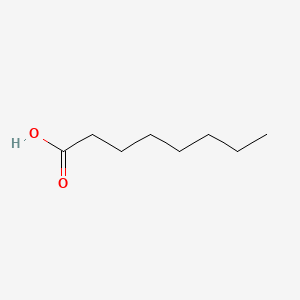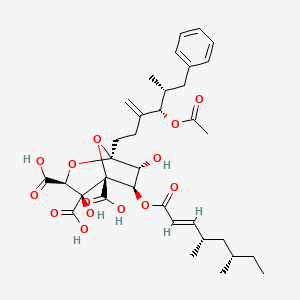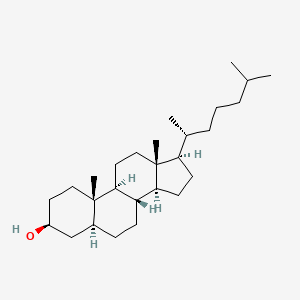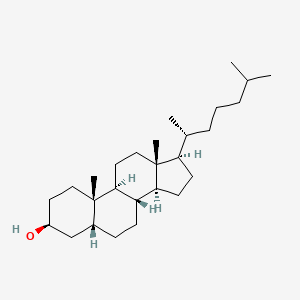
|
acetic acid |
acetic acid is a lipid of Fatty Acyls (FA) class. Acetic acid is associated with abnormalities such as Vitamin B 12 Deficiency. The involved functions are known as Excretory function. The related lipids are Propionate. |
89633 |

|
octanoic acid |
octanoic acid is a lipid of Fatty Acyls (FA) class. Octanoic acid is associated with abnormalities such as Ischemia, Diabetes Mellitus, Non-Insulin-Dependent, Diabetes, Cardiomyopathies and Obesity. The involved functions are known as Anabolism, 5-(carboxyamino)imidazole ribonucleotide mutase activity, Citric Acid Cycle, Metabolic Inhibition and Excretory function. Octanoic acid often locates in Pore, Protoplasm, Endothelium, Mitochondria and Muscle. The associated genes with octanoic acid are P4HTM gene, CPT1A gene, HADH gene, ACSL1 Gene and CD36 gene. The related lipids are Fatty Acids, Nonesterified Fatty Acids, Oleates, Palmitates and hexanoic acid. |
3349 |

|
11beta-PGF2 |
11beta-pgf2 is a lipid of Fatty Acyls (FA) class. |
15009 |

|
Triolein |
Triolein is a lipid of Glycerolipids (GL) class. Triolein is associated with abnormalities such as Lymph fistula and Hyperlipidemia. The involved functions are known as Exocytosis, cholesterol transport and lipoprotein lipase activity. Triolein often locates in Mucous Membrane, Hepatic and Intestinal Mucosa. The related lipids are Cholesterol, Dietary. The related experimental models are Knock-out. |
2752 |

|
Zaragozic acid A |
Zaragozic acid A is a lipid of Polyketides (PK) class. Zaragozic acid a is associated with abnormalities such as Hypercholesterolemia, Diabetes Mellitus, Non-Insulin-Dependent, Cardiovascular morbidity, Atherosclerosis and Infection. The involved functions are known as Anabolism, Sterol Biosynthesis Pathway, isoprenoid biosynthetic process, Biochemical Pathway and Adverse effects. Zaragozic acid a often locates in Endoplasmic reticulum, membrane, viral nucleocapsid location, Cell surface, Hepatic and Membrane. The associated genes with Zaragozic acid A are DPM1 gene, PMM2 gene, STN gene, SLC6A7 gene and Amyloid beta-Protein Precursor. The related lipids are Sterols, Fatty Acids, Membrane Lipids, farnesoic acid and Unilamellar Vesicles. The related experimental models are Mouse Model. |
219 |

|
tacrolimus |
Tacrolimus is a lipid of Polyketides (PK) class. Tacrolimus is associated with abnormalities such as Renal glomerular disease. The involved functions are known as inhibitors, Fungicidal activity, Metabolic Inhibition, Excretory function and Dephosphorylation. Tacrolimus often locates in Hepatic, Mitochondrial matrix and Inner mitochondrial membrane. The associated genes with Tacrolimus are RHOA gene and BGN gene. |
12730 |

|
oxytetracycline |
oxytetracycline is a lipid of Polyketides (PK) class. Oxytetracycline is associated with abnormalities such as Infection, X-linked centronuclear myopathy, Bacterial Infections, Heart failure and Onchocerciasis. The involved functions are known as Anabolism, physiological aspects, Transcription, Genetic, Fermentation and Transcriptional Activation. Oxytetracycline often locates in Chromosomes, Flank (surface region), Entire bony skeleton, Bone Marrow and Body tissue. The associated genes with oxytetracycline are Polypeptides, Homologous Gene, Gene Clusters, Locus and CYCS gene. The related lipids are LH 1 and Lipid Peroxides. The related experimental models are Disease model. |
6787 |

|
cholesterol |
cholesterol is a lipid of Sterol Lipids (ST) class. Cholesterol is associated with abnormalities such as Trypanosomiasis, Chagas Disease, Cleft Palate, Chondrodysplasia punctata 2, X-linked dominant and Child syndrome. The involved functions are known as Blood Circulation, Sterol Biosynthesis Pathway, Receptor Mediated Endocytosis, Methylation and Signal. Cholesterol often locates in Animal tissue, Blood, Membrane, Plasma membrane and peroxisome. The associated genes with cholesterol are MBD2 gene, SIM, SLC33A1 gene, Genome and NSDHL gene. The related lipids are Sterols, zymosterol, fecosterol, Total cholesterol and 7-dehydrocholesterol. The related experimental models are Mouse Model, Knock-out, Genetically Engineered Mouse and Disease model. |
98461 |

|
Dihydrocholesterol |
Dihydrocholesterol is a lipid of Sterol Lipids (ST) class. Dihydrocholesterol is associated with abnormalities such as Exanthema, Morphologically altered structure, protrusion, Dehydration and Xanthoma. The involved functions are known as Regulation, Biochemical Pathway, Methylation, Metabolic Inhibition and Biosynthetic Pathways. Dihydrocholesterol often locates in envelope, Mitochondria, Lipid Bilayers, Host Cell and Membrane. The associated genes with Dihydrocholesterol are GRAP2 gene, PTP4A2 gene, HSD3B7 gene, MBD2 gene and IGF2BP3 gene. The related lipids are Sterols, Cardiolipins, Pregnanes, 7-hydroxy-4-cholesten-3-one and Hydroxycholesterols. The related experimental models are Mouse Model. |
281 |

|
Coprosterol |
Coprosterol is a lipid of Sterol Lipids (ST) class. Coprosterol is associated with abnormalities such as Cerebrovascular accident, Glycogen Storage Disease Type IV, Coronary Arteriosclerosis, CARDIAC EVENT and Diabetes Mellitus, Non-Insulin-Dependent. The involved functions are known as cholesterol absorption, Death, Sudden, Cardiac, Drug Interactions, Cholesterol Homeostasis and Synthesis. Coprosterol often locates in lipid raft, Tissue membrane, Membrane, Blood and Body tissue. The associated genes with Coprosterol are ABO gene, STN gene, Alleles, Apolipoprotein E gene and TNF gene. The related lipids are saturated fat, campesterol, lathosterol, Sterols and Total cholesterol. The related experimental models are Rodent Model. |
165 |









